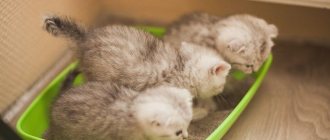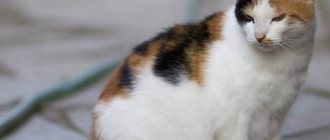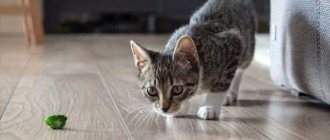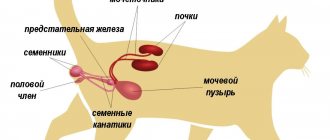When do cats start walking?
It would seem that only recently the fluffy little ball was playing with a ball of thread, but after 6 - 8 months of life, the cat has entered puberty and is ready to become a mother. Around this time, the owners are faced with the animal's first heat. It is difficult to notice an estrus, the symptoms lie solely in behavior - excessive affection, persistent cries, the cat fawns, takes a characteristic position for mating (falls on its front paws). Owners must be attentive, especially if the animal does not leave the apartment. Not finding a male, the pet will try to leave the apartment by any means. Experienced breeders know that to give birth to healthy kittens, the cat must be at least 16 - 20 months old.
It is difficult to answer the question of how long cats walk, especially for the first time, with specific numbers. Each animal will have its own characteristics. Which can only be calculated by observing the sexual cycle of your pet. In addition, one cannot ignore environmental conditions, namely the nature of nutrition and maintenance, and the breed of the cat. One way or another, all these components determine the duration of estrus. But there are still averages, namely 5 - 7 days, this is the duration of estrus in the feline family.
How many times do cats go for walks? In animals that live outside or older pets, the onset of estrus is associated with the seasons, usually spring and autumn. For cats that constantly live in an apartment and do not leave its confines, or take short walks in the country, more frequent estrus is typical, which can be explained by comfortable living conditions. The average interval between estrus in a healthy animal is 15 - 25 days, but there are exceptions and features.
Duration of estrus
The length of a cat's cycle is determined individually for each individual. For the first time it can last 5-10 days, and sometimes reach 15-25 days and change as the hormonal balance changes. These indicators differ in animals of different breeds:
- Fold and British cats mature closer to a year, estrus lasts up to a week and occurs 3-4 times a year in Scottish cats, and no more than 2 times in British cats;
- in Persians, ovulation begins at six months of age, lasts 3-7 days and occurs quite often;
- in Bengal and Thai cats, puberty is most often observed from 6-8 months, cyclically once every 1-3 months, for 5-8 days;
- Siamese breeds and sphinxes walk 5-7 days every month, starting from a year;
- bobtails mature at 8-10 months, and in cats with medium hair there are 1-4 annual cycles of 4-6 days, and in short-haired cats - 6-7 of 10 days.
The cat is walking: solving the problem
There are 3 solutions to the problem: let the cat satisfy its maternal instincts. The 2nd option is to use drugs to regulate sexual desire, and the 3rd, definitive option is surgical intervention (sterilization).
The main disadvantage of sterilization is that it is an irreversible process. In addition, there are other complications. The operation is carried out under general anesthesia; there is always a chance that the animal will not wake up. Postoperative consequences include a difficult recovery period, suppuration of the sutures, changes in hormonal levels, which can cause the animal to develop obesity, deteriorate character, etc.
Still, it is more effective and safe to use drugs to regulate sexual heat. Veterinary pharmacies offer a wide range of products. The main selection criteria are the cat’s age and breed. The most popular is the “Sex Barrier”.
Why does a cat walk after sterilization? The answer to the question is quite simple, the most important thing is to understand the terminology and understand the reasons for the occurrence of “desire in cats.”
Sterilization refers to the removal of reproductive organs - the uterus and ovaries; a cat cannot become pregnant because the necessary organs are missing. The whole difficulty lies in when sterilization occurred and how well.
If you sterilize an adult cat that has had repeated heats, then after the operation “hunting for a male” will also be present, but the animal will not be able to bear offspring. It’s another matter when a young cat, who has not yet had any desire, is properly sterilized. In this case, the likelihood of “begging behavior” is reduced to nothing.
It is worth remembering that the instinct to reproduce is basic, it is inherent in nature. And the main task of the owners is to help their pet during this difficult period, especially if it is not possible to fully realize it. The choice of method falls entirely on the shoulders of the breeders, and responsibility for the consequences, accordingly, too.
If there is a pet in the house, the family is considered happy. It’s so nice when a cat runs out to greet a person after he comes home! However, not everything is so simple, because the pet has moments when it causes inconvenience to the owner. First of all, it's estrus. Therefore, in this article I would like to talk about how many days cats walk, and how you can help the animal cope with this condition.
Ways to solve the problem
Castration of cats and sterilization of females are operations to remove reproductive organs from animals.
As a result, pets are not able to reproduce; they stop producing hormones that provoke the onset of sexual heat.
These methods of solving the problem have the following advantages:
- the male stops marking the territory, damaging the furniture, the female stops asking for the cat;
- the desire to run away from home and go for walks throughout the mating season disappears;
- pets become calm and affectionate;
- there is no need to regularly give hormonal drugs to suppress and eliminate signs of sexual heat.
Sterilization
Sterilization of cats is a surgical operation to remove the reproductive organs, which helps prevent unwanted pregnancies, unnatural behavior and hostility during the hunting season. The cat loses interest in the opposite sex, and its ability to reproduce disappears.
Sterilization can be carried out throughout the cat’s life, but it is better to do it immediately after puberty (7-9 months of age). There is an opinion among owners that the cat must be allowed to give birth at least once, but this is not so. You should not sterilize your cat before puberty, because... there may be deviations in physiological maturation.
The advantages of sterilizing a cat are as follows:
- no need to get rid of kittens;
- comfortable behavior of the animal;
- helps to increase the life expectancy of the pet;
- prevention of the development of diseases of the cat’s reproductive organs;
- reducing the risk of contracting infectious diseases in case of escape.
Castration
Castration of a cat is the surgical removal of testicles. In this case, the pet loses the ability to reproduce offspring, testosterone stops being produced. The best time to castrate a cat is when it is sexually mature and ready to breed (from about 7 to 12 months).
The operation itself is quite simple, does not threaten the health of the pet and does not require special postoperative care. There are cases when the veterinarian prescribes, if necessary, additional examination methods (tests, ultrasound, cardiogram).
You can castrate a cat for the following reasons:
- medical indications (for injuries, pathologies, orchitis);
- reduction of aggressiveness during sexual hunting;
- to eliminate or prevent unpleasant odor from a cat in an apartment as a result of marking the territory;
- prevention of prostatitis and cancer in pets.
You can castrate a cat either in a veterinary clinic or at home. The second option is more preferable, because the animal will avoid additional stress from transportation and contact with sick animals.
Hormonal drugs
Recently, more and more owners of cats and female cats are inclined to solve the problems of sexual hunting with the help of special medications, which are available in the form of tablets, drops or injections. This method allows you to avoid surgical intervention in your pet's body.
The disadvantage of using such drugs is the high concentration of hormones, which, if used for a long time, can cause hormonal imbalances in the pet’s body and, as a result, the occurrence of serious diseases. After the first use of the drug, the animal experiences general lethargy and detachment.
In cats, with regular use of hormonal drugs, diabetes mellitus can begin, ovarian cysts form, pyometra (purulent inflammation of the uterus) develops, and cancer is possible. In cats, there are inflammatory processes in the reproductive organs and cancer.
Veterinarians are unanimous in their opinion: compared to chemical and hormonal agents, surgery is more preferable. Long-term and, as a rule, uncontrolled use of hormonal drugs is fraught with serious health problems in the pet’s adulthood.
Age
If a family decides to get a kitten, there is a lot to know about it. One of the control points is when the animal becomes a fully mature individual. After all, regardless of the gender of the pet, he will somehow need to experience the time of his own sexual activity. So, the approximate age for cats (females) is 5-6 months. Don’t be afraid, because these animals happen much earlier than the physical one. However, there are some nuances that affect what time cats start walking. So, it depends on the pet’s diet, its habitat, climate and other indicators. Sometimes this period can be somewhat delayed, and the cat’s first “gurgling” will occur only at the 14-15th month of life. Another nuance: it is believed that they mature and become sexually mature much earlier than their long-haired sisters.
Puberty
Males reach sexual maturity a little later than females. So, if a cat becomes ready to mate at the age of 5-6 months, then males become ready to mate from 9 to 12 months. There are cats that mature by the age of two, and this depends on many factors - diet, the presence of an animal of the opposite sex in the house, genetic characteristics.
Factors determining the period of onset of puberty:
- breed affiliation;
- skeletal structure (elegantly built pets with a fine bone structure, mature earlier than their more powerful relatives);
- season;
- habitat;
- predisposition at the genetic level.
The time when a cat matures for procreation is marked by the beginning of marks. The animal begins to mark the territory in which it considers itself the rightful owner. It is rare, but it happens that a cat does not mark the room in which it lives.
The period of intensification of sexual desire usually occurs in the spring. But cats, unlike cats, can mate all year round. This is due to the fact that males have their own specific periods of activity, depending on the individual characteristics of the body.
About deadlines
Understanding the question of how many days cats walk, it should be noted for starters that this will happen at least twice a year. However, this is a rather arbitrary indicator, because usually the process is observed much more often. As for the first heat, it mainly occurs at the end of winter or beginning of spring. This is especially true for older breeds and in which such periodicity is inherent at the genetic level. So if a cat was born in the second half of the year, it is not surprising that she will want to “walk” already at the age of five to six months. You need to be prepared for this.
Regulation of sexual estrus
If the cat is purebred and the owner plans to get offspring from such a cat in the future, then it is recommended to breed him with cats that have a good pedigree. In some cases, breeders advise buying a female that has previously been sterilized (ligation of appendages). The cat will be ready to mate, but in this case there will be no offspring. It will be easier for the cat to cope with his natural instincts, finding an outlet for energy.
Another method that allows you to calm a cat during the mating season is the use of special hormonal drugs. All contraceptives are designed to artificially suppress an animal's desire to mate. In addition, when taking hormonal substances, signs of sexual desire decrease.
Note! The dosage and timing of taking hormonal drops or tablets should be prescribed exclusively by a veterinarian after prior consultation.
Medications for regulating sexual desire can be of plant or hormonal origin. Hormonal drops are widely used in home practice, giving an easy and quick effect, but not long-lasting. A large number of cat lovers believe that the use of oral contraceptives for cats in the form of drops or tablets is much more humane than sterilization or castration.
There is an opinion that this is a safer method of regulating sexual desire. Veterinary experts and scientists say that tablets and drops are a time bomb. A one-time use of a hormonal drug once a year (for example, in the spring) will not harm the body.
Systematic, constant use of drops can cause serious disorders in the animal’s body, including death. This is due to the fact that contraceptives for cats contain a dose of a hormonal substance that blocks the production of physiological hormones.
Duration
What exactly is estrus? This is the period when the cat is ready to give birth, and at this time she is looking for a suitable partner. If this does not happen in the first days of the “walk,” such a languid state of the cat may drag on somewhat and take from several days to two weeks. Here is the answer to the question of how many days cats walk. It should be noted that an animal may not become pregnant during this entire period. The ability to breed lasts only a few days (about 2-4). If you need to find out how long a cat walks for the first time, the timing will be the same, and everything will depend on the animal itself.
Estrus: Stage 1. Flirting
When understanding the question of how many days cats walk, it is also important to find out what happens to the animal’s body during this period. So, the heat itself has four stages. However, since these animals do not have bleeding, the condition of the pet can only be determined by its behavior. The first stage of estrus - proestrus - is the most restless for both the pet and its owner. At this time, the animal often does not find a place for itself, makes low throat sounds; if you look closely, you can see the pet’s genitals somewhat swollen. Also at this time, the cat’s appetite may increase, and it may pester its owner. If translated into human language, then this is the time of courtship. The cat is theoretically already ready for sexual intercourse, but will not allow the cat to approach her yet. It is the presence of a male individual nearby that influences the production of the necessary hormone for fertilization.
Estrus: stage 2. Intimacy
The next stage is estrus. This is the time when animal intimacy can happen. When figuring out how long a cat walks, it should be noted that this particular time can be quite different and last from several days to a couple of weeks. What will happen to the pet depends on its temperament. So, some “ladies” will scream loudly, while others will simply lie on the floor, actively reacting to every male representative (even if it is a human man and not a cat). It is at this time that the cat makes sounds that are similar to cries of pain. However, this is exactly how she encourages cats to be intimate. If the owner waits for a given time for the planned mating of the animal, then it is not difficult to determine it. It is enough just to run along the cat’s back from the scruff to the tail. If the pet begins to arch, squatting on its front legs and standing up on its hind legs, sticking out the back of its body and moving its tail, the cat is ready for sexual intercourse. It is important to note that during this period the animal may not eat and urinate frequently - this is the normal state of the “walking” organism.
Signs of hormonal changes and sexual heat
Signs of heat in cats are as follows:
- onset of estrus;
- refusal to eat;
- the cat becomes affectionate, rubs against the owner’s legs, rolls on the floor, walks with its tail turned to the side, lifts the back of its body up;
- meowing and calling calls (both day and night);
- licking the genitals during estrus (this way the cat removes secretions), frequent urination;
- constant attempts to escape from home.
Signs of sexual heat in males:
- loud screams turning into wild screams;
- aggressive behavior (bites and scratches furniture, can attack a person) and actively marks the territory in the living room;
- constant attempts to escape to the street;
Cats are in heat all year round.
Estrus: Stage 3. Definition
The name of the third stage of the reproductive cycle is metestrus. Its duration, on average, is 10 days, but can vary from 2 to 19 days. At this time, the cat is no longer interested in a representative of the opposite sex, and events will develop depending on whether fertilization has occurred. So, if everything was according to the rules, the animal will calm down, and the sexual instinct will fade away. If mating does not occur, within a couple of days everything can begin anew, from the first stage - poestrus.
What to do?
Knowing how long your cat spends walking, you can try to make this period easier for her. After all, this is still a certain stress for the animal’s body. The best way is, of course, mating an animal, but you cannot do this every “walk.” After all, fertilization can occur, and it is often undesirable for a cat to become pregnant. The ideal period is if a year passes from the last birth to the moment of conception. What else can be done: at this time, you need to devote more time to your pet: walk with it, care for it, show care. This way you can distract the animal. You can also give your cat special medications that are sold in veterinary pharmacies. They calm the animal and help it survive this period without any problems. However, veterinarians say that you can “stifle” the instinct only two or three times. Next you need to take the cat for mating. After all, if this does not happen, problems with the ovaries may begin. If the owner does not plan to “breed” the pet at all, it is better for her to have a special operation. Then such problems will no longer arise.
Having sheltered a kitten in the house, the owners are touched by its charm and funny antics. But after a few months, the furry baby grows up and begins to demand adulthood. Owners are wondering when cats start walking.
About the period when a cat turns from a small kitten into an adult cat, they say “the cat is walking.” The pet succumbs to instinct and decides to continue its cat family. But, often, she does not find a gentleman for herself in her home, so she devotes her screams and insistent demands entirely to the owners. The owners, in turn, get tired of listening to mating songs and begin to look for a way to calm down the matured cat.
The first thought about gentlemen creeps into the cat at ten months. It is during this period that the animal becomes ready for procreation. However, owners should remember that at this age the cat has not yet fully formed, and early pregnancy can harm the young body.
When the first symptoms of “adulting” occur, it is necessary to ensure that the cat does not go outside in search of her chosen one. Even the most domestic cats, who have never left the apartment, are interested in walks when they come into heat and can easily run away in search of happiness.
When estrus occurs, owners may decide to wait out this period or allow the cat to get to know the cat. In any case, it is necessary to know the symptoms of the onset of adulthood in a cat.
First of all, changes are noticeable in behavior. The cat becomes extremely affectionate and flexible. Even the cat, who just yesterday tried to bite off your hand in the midst of a game, today becomes indecently tame. This is the first sign of “growing up.”
Realizing that she won’t achieve anything with tenderness alone, the cat turns on her voice. There is no more persistent animal than a murka preparing for a wedding. She is ready to meow loudly and around the clock. This undoubtedly helps owners make a decision faster if one has not been made before. Particularly vocal singers are taken to the cat, and the rest are treated to pills.
If the cat's screams do not melt the owner's heart, the cat takes up gymnastic exercises. She characteristically falls on her front paws, raising her butt, and spends quite a lot of time in this position. Nobody canceled the songs, so gymnastics is accompanied by extremely “melodic” singing.
In addition to the symptoms described, the following signs are observed:
- Loss of appetite. A cat seeking comfort may even ignore its favorite treats.
- Personal care. Murka spends a long time licking himself and visits secluded places more often than usual.
- Estrus is accompanied by slight swelling of the animal's genitals. At the same time, the cat pays special attention to this fact.
How long does a cat's heat last?
Puberty in pets causes a lot of inconvenience, so every owner should know how many days a cat walks.
The frequency of estrus depends on many factors. If a cat has already given birth to kittens, her sex life focuses on 3-4 heats per year. Young animals are characterized by more frequent searches for a partner. Often this is one heat every 2 months, less often - once every four weeks.
If owners do not plan to breed kittens, the best option is to sterilize the pet. This will allow the cat to live a calm life, without being distracted by instincts that it cannot realize. The inability to procreate causes the animal discomfort, both psychological and physical.
The nature of estrus also depends on the cat's breed. So, British cats endure this period easier than others. And the “weddings” themselves occur less frequently. Scottish cats remain calm, but play more actively and become more talkative.
The duration of estrus depends on the specific animal, its breed, and age. Often cats walk for 5-6 days and then calm down.
How to solve the problem of estrus in a cat
When pets reach puberty, the owner must decide whether his cat will participate in procreation. If the owner is ready to start breeding kittens, then it is necessary to prepare for the “wedding” even before the onset of the next heat.
If the decision is made to prevent pregnancy, then it is best to sterilize the cat. This will save the owners from regular songs that last a week, and will protect the cat from broken hopes and regular exhaustion due to falling in love.
Sometimes you have to resort to medications. The use of medications is only a temporary solution. Constantly suppressing your cat's instincts with medications can be harmful to your pet. There are two types of “helper pills”:
- Preparations based on herbal infusions. They do not harm the cat's body and are considered safe.
- Medicines. You should not often resort to such radical methods. Regular use, for example, of Suprastin, can cause poisoning, and long-term use of it provokes the occurrence of cancer.
When letting a kitten into your home, you need to familiarize yourself with the nuances that you will have to face when the baby reaches adulthood, namely when cats begin to walk.
The problem of estrus in cats requires patience from the owner. During the mating season, a cat is capable of tormenting not only herself, but also those around her with her behavior. Therefore, it is extremely important for the owner to make the right decision when the pet reaches puberty, because the use of sedatives does not solve the problem, but only postpones it.
You have a cat living at home - a sweet and affectionate creature. However, when it comes to procreation instincts, your cute animal becomes simply impossible. After all, the reproductive instinct is one of the strongest in cats. Every cat instinctively strives to procreate and become a mother. How do cats walk and what does this mean? This is what we will talk about today.
What time do cats start walking?
In cats, sexual maturity occurs at approximately five to six months. In cats, this happens a little later - at seven to eight months. However, sexual activity in most cats appears a little later. When cats start walking depends on various factors: living conditions, breed, climate and a host of other conditions. Maturity in cats and cats occurs much earlier than the development and growth of the animal ends. Often, cats do not become physically and sexually mature until they are fifteen months old.
Mating of elite breed cats
Elite cats with low temperament first show readiness to mate at the age of about a year. More active creatures or pets with hormonal imbalances can enter puberty by 4-5 months. Early estrus is extremely undesirable, as it leads to complications leading to the development of cancer.
At what age can you breed a Scottish, British, Bengal cat, in how many months, on whose territory? The first rendezvous with the groom at the pussy of the British breed should take place at the age of 12 – 16 months. The breeder needs to wait until the second or third day from the start of estrus, take the lady on a date and leave her with her partner for two to three days (the cat is bred at home). It is left to the master of the British groom to control the marriage games.
How many days does a cat walk?
Most cats come into heat twice a year, however, in some felines it happens much more often. Sometimes once a month. The estrus period can range from three days to one to two weeks. However, the ability to mate lasts only two to four days.
If the cat already had kittens and fed them, then the cat's next heat will occur three to four weeks after stopping feeding. Often, cats come into heat in early spring, early autumn or June. In the first year of a cat's life and after the animal has reached the age of seven, cats do not go into heat regularly. If you are planning to have kittens, then you should know that you should not breed a cat every time she is in heat. This is very harmful to her body. At least a year must pass since the last pregnancy for the animal’s body to recover and become strong enough before the next pregnancy.
It’s not difficult to understand that a cat wants to go for a walk. First of all, this is noticeable by the behavior of your pet, as well as by the swelling of the animal’s genitals. The animal's habits change noticeably. The cat rubs against the corners of the furniture and apartment, purrs, meows loudly and invitingly, raises its tail to the top and crouches. Transparent discharge appears from the genitals. However, it is difficult to notice them, since the cat constantly licks them.
Duration of heat
The cat shows the first signs of puberty at about six months. A delay in maturation of up to ten months is considered normal. If a female begins to estrus before six months, the animal must be sterilized to prevent the transmission of such a trait to offspring. Late maturity indicates the presence of physiological problems and is a reason to contact a veterinarian.
The duration of the estrus period changes with age: it increases with growing up, and decreases with old age. On average, sexual hunting lasts 7-8 days. In older cats, the pause between heats is longer (they walk less) than in young cats, and ovulation does not occur.
A cat that has never mated feels the need for intercourse every month. More experienced females ask for a male cat once every 3 months. A regularly mated pussy experiences estrus twice a year. Some breeds (Scottish, British, Bengals) extend the pause to eight months.
Factors influencing the duration and frequency of sexual heat: diet, temperament, proximity to males. An active and energetic animal more often feels the need for a cat than a lethargic and apathetic one.
At what months do you start breeding elite cats? The owners of a breeding cat intended for breeding should plan for their pet to meet her groom long before the onset of estrus. Most breeders consider the optimal time for the first birth to be the beginning of the animal's second year of life. The best age for a first date is ten months.
Stages of sexual hunting
Proestrus . Preliminary stage (1-4 days). The cat's behavior is particularly tender. Slight discharge appears from the swollen external genitalia.
Estrus . All characteristic symptoms are fully manifested. The cat makes screams (screams, yells), clings to people and objects. From the third to the fifth day of estrus, ovulation occurs. The highest intensity of signs of heat is observed in February and March.
Interestrus . During the period following heat, the pussy calms down. A sign that a cat is fertilized is aggression towards the male. Failure to conceive can lead to negative consequences - false pregnancy. Failure of hormone production will cause the animal to begin looking for an object for adoption. In this case, you should seek the help of a doctor.
Anestrus . This period is not marked by anything special. The animal calmly leads its usual way of life.
How many kittens does a cat have?
The average female cat can give birth to up to six kittens at lambing. This amount is optimal for a cat and is calculated according to an unspoken rule (number of nipples minus two). However, such a figure is not accurate. The number of kittens in one litter can be either more or less than six. There are some factors that affect the number of offspring your cat will have.
- The first is the age of the animal. If your cat is young and has not given birth before, she will often have one to four kittens in her first pregnancy. An experienced and mature cat can give birth to six to twelve pieces.
- The second is the health status of the animal. If a cat’s body is weakened or does not receive adequate nutrition, then such a cat is not able to bear and give birth to healthy and numerous offspring. The number of kittens in such an animal often does not exceed three or four.
- Third is heredity. If your cat was born in a multiple litter, then her chances of giving birth to numerous offspring increase significantly.











